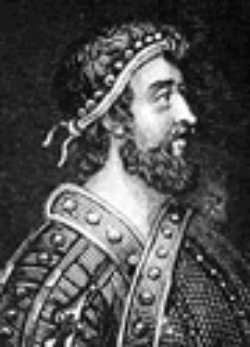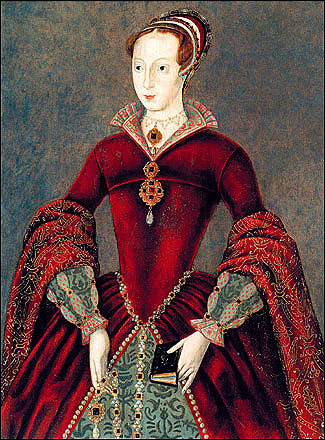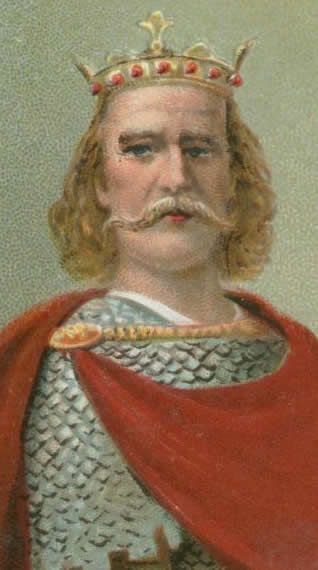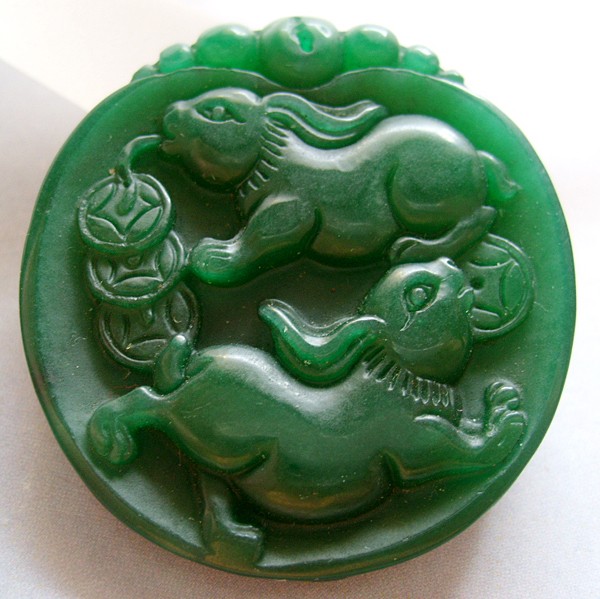Name: King Harthacnut
Born: c.1018
Parents: Cnut and Emma of Normandy
Relation to Elizabeth II: 1st cousin 28 times removed
House of: Denmark
Ascended to the throne: March 17, 1040
Crowned: June, 1040 at Canterbury Cathedral, aged c.22
Married: Unmarried
Children: None
Died: June 8, 1042 at Lambeth, London
Buried at: Winchester
Reigned for: 2 years, 2 months, and 21 days
Succeeded by: his half brother Edward
Was the eldest son of King Canute II and Emma of Normandy, the widow of Ethelred II and was therefore the heir to the English crown. He had been proclaimed king of Denmark in 1028 but when Canute died in 1035 Harthacnut was defending his land in Denmark. In his absence his illegitimate half-brother, Harold Harefoot was crowned King Harold I of England in 1037. Naturally there was a struggle between the two brothers that only ended on the death of Harold (17June 1040). Harthacnut sailed to England with a large fleet and was immediately accepted as king.
His father intended Hardicanute to become king of the English in preference to his elder brother Harold Harefoot, but he nearly lost his chance of this when he became preoccupied with affairs in Denmark, of which he was also king. Instead, Canute’s eldest son, Harold Harefoot, became king of England as a whole. In 1039 Hardicanute eventually set sail for England, arriving to find his brother dead and himself king.
King of England
Harthacnut travelled to England with his mother. The landing at Sandwich on 17 June 1040, “seven days before Midsummer”, was a peaceful one but he brought a fleet of 62 warships. Even though he had been invited to take the throne, he was taking no chances and came as a conqueror with an invasion force. The crews had to be rewarded for their service and to pay them, he levied a geld of more than 21,000 pounds, a huge sum of money which made him unpopular, although it was only a quarter of the amount his father had raised in similar circumstances in 1017-1018.
Harthacnut had been horrified at Harold’s murder of Alfred and his mother demanded vengeance. With the approval of Harold’s former councillors, his body was disinterred from its place of honour at Westminster and publicly beheaded. It was disposed of in a sewer, but then retrieved and thrown in the Thames, from which the London shipmen rescued it and had it buried in a churchyard.
Godwin, the powerful earl of Wessex, had been complicit in the crime as he had handed over Alfred to Harold, and Queen Emma charged him in a trial before Harthacnut and members of his council. The king allowed Godwin to escape punishment by bringing witnesses that he had acted on Harold’s orders, but Godwin then gave Harthacnut a ship so richly decorated that it amounted to the wergild that Godwin would have had to pay if he had been found guilty.[15] Bishop Lyfing of Worcester was also charged with complicity in the crime and deprived of his see, but in 1041 he made his peace with Harthacnut and was restored to his position.
The English had become used to the king ruling in council, with the advice of his chief men, but Harthacnut had ruled autocratically in Denmark and he was not willing to change, particularly as he did not fully trust the leading earls. At first he was successful in intimidating his subjects, though less so later in his short reign. He doubled the size of the English fleet from sixteen to thirty-two ships, partly so that he had a force capable of dealing with trouble elsewhere in his empire, and to pay for it he severely increased the rate of taxation. The increase coincided with a poor harvest, causing severe hardship. In 1041 two of his tax gatherers were so harsh in dealing with people in and around Worcester that they rioted and killed the tax gatherers. Harthacnut reacted by imposing a then-legal but very unpopular punishment known as ‘harrying’. He ordered his earls to burn the town and kill the population. Very few people were killed as they knew what was coming and fled in all directions.
The earl of Northumbria was Siward, but Earl Eadwulf of Bernicia ruled the northern part in semi-independence, a situation which did not please the autocratic Harthacnut. In 1041 Earl Eadwulf gave offence to the king for an unknown reason but then sought reconciliation. Harthacnut promised him safe conduct, but then colluded in his murder by Siward, who became earl of the whole of Northumbria. The crime was widely condemned, and the Anglo-Saxon Chronicle described it as “a betrayal” and the king as an “oath-breaker”.
Harthacnut was generous to the church. Very few contemporary documents survive, but a royal charter of his transferred land to Bishop Ælfwine of Winchester, and he made several grants to Ramsey Abbey. The twelfth-century Ramsey Chronicle speaks well of his generosity and his character.
Harthacnut had suffered from bouts of illness even before he became King of England. He may have suffered from tuberculosis, and he probably knew that he had not long to live.
In 1041 he invited his half-brother Edward the Confessor (his mother Emma’s son by Æthelred the Unready) back from exile in Normandy and probably made him his heir. He may well have been influenced by Emma, who hoped to keep her power by ensuring that one of her sons was succeeded by another. Harthacnut was unmarried and had no known children.
Death
On 8 June 1042, Harthacnut attended a wedding in Lambeth. The groom was Tovi the Proud, former standard-bearer to Cnut. The bride was Gytha, daughter of the courtier Osgod Clapa. Harthacnut presumably consumed large quanties of alcohol, as he was drinking to the health of the bride — he “died as he stood at his drink, and he suddenly fell to the earth with an awful convulsion; and those who were close by took hold of him, and he spoke no word afterwards… The likely cause of death was a stroke, “brought about by an excessive intake of alcohol” In The Death of Kings: A Medical History of the Kings and Queens of England (2000), Clifford Brewer suggested a cardiac arrest as the immediate cause of death.
Harthacnut was buried at Old Minster in Winchester, his father’s place of rest. His mother donated a valuable relic, the head of Saint Valentine to New Minster, her offer for the salvation of his soul.[9][20] In 1052, Emma herself was buried at Old Minster. Her surviving son, Edward the Confessor, had assumed the throne on Harthacnut’s death, restoring the Saxon royal line of the House of Wessex.
A contradictory account in the Knýtlinga saga (13th century), reports Harthacnut buried in the city of Morstr, alongside his half-brother Harold Harefoot and their father Cnut. While mentioned as a great city in the text, nothing else is known of Morstr.[23][24] The Heimskringla by Snorri Sturluson reports Harthacnut buried at Winchester, alongside Cnut and Harold Harefoot.
Ian Howard speculates that Harthacnut could have been suffering from a terminal illness, such as tuberculosis, something known to himself and his court for a while. This would explain why Emma turned her attention to her other son, Edward, why Magnus seriously expected to succeed the rival king, and why Henry III was eager to have a connection to the Danish monarch (see succession below). While Harthacnut was fairly young, several people were interested in designating an heir for him, as if the young man was already dying, and was not expected to have sons of his own.
Alan R. Rushton notes that Harthacnut was son to Emma of Normandy, and that there was a pattern of sudden deaths among descendants of the House of Normandy. In 1027, Richard III, Duke of Normandy died with no apparent reason. Widespread rumors suggested that his brother and heir, Robert I, Duke of Normandy, had him poisoned. Robert I himself went on pilgrimage to Jerusalem. In 1035, Robert died in Nicaea, Bithynia during his return journey. A contemporary chronicler suspected poisoning as the reason behind the sudden death. In 1040, their cousin Alan III, Duke of Brittany died of unexplained causes. Again poison was suspected as the reason. In 1066, his son Conan II, Duke of Brittany also died of unexplained causes. His cousin William the Conqueror was suspected of having him poisoned.
Rushton notes that historians for centuries believed that poison was indeed the most likely explanation behind “an otherwise unexplained death”. He speculates, however, that the actual cause could be a hereditary disease, an autosomal dominant pattern. He admits that William the Conqueror, another descendant of this dynasty, generally enjoyed good health but points out that William fell seriously ill following the Battle of Hastings (1066), resting for a month near Canterbury. He then had to return to Normandy for further medical attention. His health problems were attributed to a combination of exhaustion, dysentery and chronic gout.
Twenty years later, William was incapacitated by abdominal colic, supposedly caused by the bow of his saddle. He rested in a monastery near Rouen for three weeks, then died. Symptoms of his last days included a fever and a marked sensitivity to noise. Rushton suspects that William himself could have been suffering from “an unknown ailment.”
On the other hand, David C. Douglas had pointed out that “allegations of secret poisoning” were rather common in the primary sources from 11th-century Normandy. Any writer on Norman affairs attributed to venom any sudden death, except those involving violence.
Surprisingly, these allegations were rare in sources from 11th-century England, even when the sudden deaths would justify the suspicion. He noted the deaths of Harthacnut (1042), Godwin, Earl of Wessex (1053), and Edward the Exile (1057) formed a suspect pattern, though the primary sources were silent on the subject. He believes that, had the deaths occurred in the Duchy of Normandy, the matter would be seen in a different light.[29][30] Kelly DeVries noted that while Douglas implied that Harthacnut was poisoned, he did not further explore the notion, never mentioning potential murderers or their motivation.
Sten Körner also noted that the death of Harthacnut could be part of a plot, but also did not further explore the notion though the implication would be that Edward the Confessor was behind this plot.[32] In The Death of Kings: A Medical History of the Kings and Queens of England (2000), Clifford Brewer pointed that Edward benefited from the sudden death of Harthacnut and that Godwin, Earl of Wessex, was the father-in-law to Edward, but once led an uprising against his son-in-law. He died suddenly after dining with said son-in-law, again pointing suspicion at Edward, as the probable culprit behind both deaths. Katherine Holman was certain that Harthacnut was poisoned, but felt that the culprit will never be known with certainty due to “no shortage of discontented candidates.”
Succession
The political agreement between Harthacnut and Magnus I of Norway (see above) included the appointment of the latter as heir to Harthcanut. At the time, the agreement would have only affected the throne of Denmark. The Heimskringla reports that when Harthacnut died, Magnus extended his claim to England. He reportedly send a letter to Edward the Confessor, pressing his claim to the English throne and threatening with invasion. His own heir, Harald Hardrada, would also press this claim. Both considered themselves legal heirs to Harthacnut. The Fagrskinna contains a scene where Magnus proclaims that “I will take possession of all the Danish empire or else die in the attempt.”
According to the Encomium (see above), Edward the Confessor already served as co-ruler of England since 1041. There is an emphasis on Harthacnut, Edward and Emma serving as a trinity of rulers, in emulation of the Holy Trinity. Edward, by surviving his co-ruler, would be king by default. The Heimskringla depicts Edward portraying himself as brother and legal heir to both Harold Harefoot and Harthacnut while pointing out that he had already won the support “of all the people of the country”. Unstated in both is that the marriage of Edward to Edith of Wessex would also support his claim by earning him both the political support of her father Godwin, and an additional connection to Cnut. She was a niece to the king.[26] The Fagrskinna has Edward point out that he was the son of Æthelred the Unready and Emma of Normandy, the brother to Edmund Ironside, the stepson of Cnut, the stepbrother of Harold Harefoot, and the half-brother of Harthacnut. In short, he had a much stronger family claim to the throne than Magnus. All the leaders of England had already acknowledged him as their king, and he was consecrated by an archbishop. England was his own heritage. Whether Magnus managed to defeat him in war or not, “you can never be called king in England, and you will never be granted any allegiance there before you put an end to my life.” This was supposedly enough to cause Magnus to doubt the strength of his own claim.
The marriage agreement between Gunhilda of Denmark (sister of Harthacnut) and Henry III, Holy Roman Emperor would allow descendants of this marriage to claim the throne of Denmark and potentially England. The marriage, from Henry’s perspective, was probably orchestrated to allow the Holy Roman Empire to claim control of Denmark and the western areas of the Baltic Sea. However, Gunhilda had died in 1038 with no known sons. Her only daughter was Beatrice I, Abbess of Quedlinburg, who never married.
If Harthacnut was known to be dying from an illness (see above), the early attempts of several people to regulate his succession could be seen in a different light. It appears the “sudden” death was actually long expected.[26]
Reputation
Apart from the Ramsey Chronicle, medieval sources are hostile to Harthacnut. According to the Anglo-Saxon Chronicle he “did nothing worthy of a king as long as he ruled.” Modern historians are less dismissive. In the view of M. K. Lawson, he had at least two of the requisites of a successful medieval king, he was “both ruthless and feared”; had he not died young, the Norman Conquest might not have happened. Ian Howard praises Harthacnut for keeping peace throughout his empire, benefiting trade and merchants, and ensuring a peaceful succession by inviting Edward to his court as his heir. Had he lived longer, Howard believes, his character might have enabled him to become a successful king like his father.
Henry of Huntingdon (12th century) claimed that Harthacnut ordered for the dining tables of his court to be “laid four times a day with royal sumptuousness” which O’Brien says is likely a popular myth.[20] Henry of Huntingdon viewed this detail in the context of the monarch sharing these meals with the members of his household, making Harthacnut more generous than his own contemporaries, who “through avarice, or as they pretend through disgust, …set but one meal a day before their dependents”. His account produced the image of Harthacnut as a “very generous bon viver.” Ranulf Higden (14th century) viewed the same detail in a negative light. He claimed that Harthacnut insisted on having two dinners and two suppers per day. His example influenced the English people, who supposedly were to Higden’s day gluttonous and extravagant. Higden so claimed that Harthacnut had a lasting effect on the English national character.
The association of Harthacnut with gluttony was well-known enough to appear in the novel Ivanhoe (1819) by Walter Scott. The character Cedric comments on his friend Athelstane, whose main character trait is a love for food and drink, that “The soul of Hardicanute hath taken possession of him, and he hath no pleasure save to fill, to swill, and to call for more.”
The Knýtlinga saga treats the death of Harthacnut as the end of an ancient line of kings, and notes that he was the last Danish king to rule over England. But otherwise Harthacnut is treated as a mere footnote in the line of monarchs, while there are many observations on Cnut. Morkinskinna covers Harthacnut’s death in some detail, but records next to nothing about his life, suggesting a lack of memorable details on him, presumably due to his short reign.
The prose Brut chronicle was an Anglo-Norman work, covering British and English monarchs from Brut (Brutus of Troy) to the death of Henry III in 1272. It was probably written during the reign of Edward I (reigned 1272–1307), though the oldest surviving manuscript dates to 1338. The text often includes notable errors. The original author remains unknown, but there were a number of continuations by different hands, continuing the story to the Battle of Halidon Hill (1333). The material on Harthacnut is largely positive. The author considered both Harold Harefoot and Harthacnut to have been sons of Cnut and Emma of Normandy. He portrays Harold as lacking in chivalry, courtesy, and honor. While Harthacnut was “…a noble knight and stalwart of body, and he greatly loved knighthood and all virtues.” He praises Harthacnut for his generosity with food and drink, claiming that his table was open “…for all who wished to come to his court to be richly served with royal dishes”. He concludes by portraying Harthacnut as a loyal son for accepting his mother, Emma, back to court.
Contradictory account of his death
There is a contradictory account of Harthacnut’s death featured in the Morkinskinna (13th century). According to this account, Magnus I of Norway (reigned 1034–1047) visited the court of Harthacnut in Denmark, received with all official honors. The two monarchs then argued on a matter of etiquette, on whether the host or the guest should drink first. Each man offering the honor to the other. The two eventually agreed that the host should drink first. Then Álfífa (Ælfgifu of Northampton) entered the royal hall, welcoming Magnus. She poured a drink for him. But the guest offered the drink to Harthacnut. He drank from the drinking horn and fell dead, poisoned. Álfífa had thus intended to poison Magnus, but accidentally killed Harthacnut instead. She fled to escape punishment.
The tale is probably fictional in origin, though consistent with the villainous depiction of Ælfgifu in this work. A nearly identical story appears in the Egils saga, though the three protagonists are different, with Egill Skallagrímsson as the intended victim, with Bárðr of Atley and Gunnhild, Mother of Kings as the would-be poisoners.
| Timeline for King Harthacnut |
| 1040 | Harold Harefoot dies and Harthacanute accedes to the throne |
Credits:
Wikipedia











